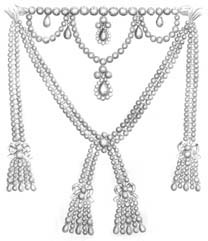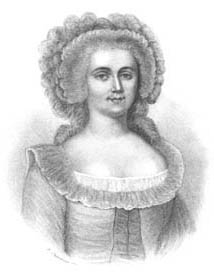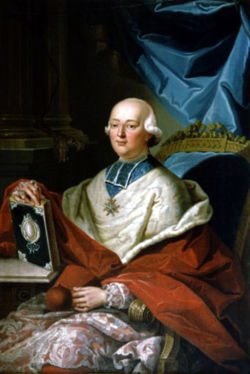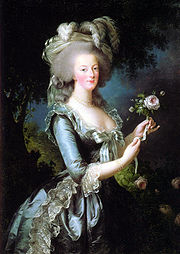
Affair of the diamond necklace
Encyclopedia

Louis XVI of France
Louis XVI was a Bourbon monarch who ruled as King of France and Navarre until 1791, and then as King of the French from 1791 to 1792, before being executed in 1793....
of France
France
The French Republic , The French Republic , The French Republic , (commonly known as France , is a unitary semi-presidential republic in Western Europe with several overseas territories and islands located on other continents and in the Indian, Pacific, and Atlantic oceans. Metropolitan France...
involving his wife, Queen Marie Antoinette
Marie Antoinette
Marie Antoinette ; 2 November 1755 – 16 October 1793) was an Archduchess of Austria and the Queen of France and of Navarre. She was the fifteenth and penultimate child of Holy Roman Empress Maria Theresa and Holy Roman Emperor Francis I....
. The reputation of the Queen, which was already tarnished by gossip, was ruined by the implication that she had participated in a crime to defraud the crown jewellers of the cost of a very expensive diamond necklace. The Affair was historically significant as one of the events that led to the French populace's disillusionment with the monarchy
Monarchy
A monarchy is a form of government in which the office of head of state is usually held until death or abdication and is often hereditary and includes a royal house. In some cases, the monarch is elected...
, which, among other causes, eventually culminated in the French Revolution
French Revolution
The French Revolution , sometimes distinguished as the 'Great French Revolution' , was a period of radical social and political upheaval in France and Europe. The absolute monarchy that had ruled France for centuries collapsed in three years...
.
Background
In 1772, Louis XVLouis XV of France
Louis XV was a Bourbon monarch who ruled as King of France and of Navarre from 1 September 1715 until his death. He succeeded his great-grandfather at the age of five, his first cousin Philippe II, Duke of Orléans, served as Regent of the kingdom until Louis's majority in 1723...
decided to make Madame du Barry
Madame du Barry
Jeanne Bécu, comtesse du Barry was the last Maîtresse-en-titre of Louis XV of France and one of the victims of the Reign of Terror during the French Revolution.-Early life:...
, with whom he was infatuated, a special gift at the estimated cost of 2,000,000 livres. He requested that Parisian jewelers Boehmer and Bassenge create a diamond necklace which would surpass all others in grandeur. It would take the jewelers several years and a great deal of money to amass an appropriate set of diamonds. In the meantime, Louis XV died of smallpox
Smallpox
Smallpox was an infectious disease unique to humans, caused by either of two virus variants, Variola major and Variola minor. The disease is also known by the Latin names Variola or Variola vera, which is a derivative of the Latin varius, meaning "spotted", or varus, meaning "pimple"...
, and du Barry was banished from court by his successor.
The necklace consisted of many large diamonds arranged in an elaborate design of festoons, pendants and tassels. The jewelers hoped it could be a product that the new Queen of France, Marie Antoinette, could buy and indeed in 1778 the new king, Louis XVI
Louis XVI of France
Louis XVI was a Bourbon monarch who ruled as King of France and Navarre until 1791, and then as King of the French from 1791 to 1792, before being executed in 1793....
, offered it to his wife as a present, but she refused. According to Madame Campan
Jeanne-Louise-Henriette Campan
Jeanne-Louise-Henriette Campan, born Henriette Genet was a French educator and lady-in-waiting to Queen Marie Antoinette before and during the French Revolution....
, the Queen refused it with the statement that the money would be better spent equipping a man-of-war. Some said that Marie Antoinette refused the necklace because she did not want to wear any jewel which had been designed for another woman, especially if that woman was a courtesan
Courtesan
A courtesan was originally a female courtier, which means a person who attends the court of a monarch or other powerful person.In feudal society, the court was the centre of government as well as the residence of the monarch, and social and political life were often completely mixed together...
disliked by the Queen. According to others, Louis XVI himself changed his mind.
After having vainly tried to place the necklace outside of France, the jewelers again attempted to sell it to Marie Antoinette after the birth of the dauphin Louis-Joseph in 1781. The Queen again refused.
The Affair

Legitimacy (law)
At common law, legitimacy is the status of a child who is born to parents who are legally married to one another; and of a child who is born shortly after the parents' divorce. In canon and in civil law, the offspring of putative marriages have been considered legitimate children...
son of Henry II of France
Henry II of France
Henry II was King of France from 31 March 1547 until his death in 1559.-Early years:Henry was born in the royal Château de Saint-Germain-en-Laye, near Paris, the son of Francis I and Claude, Duchess of Brittany .His father was captured at the Battle of Pavia in 1525 by his sworn enemy,...
, Jeanne de Valois had married an officer of the gendarmes
Gendarmerie
A gendarmerie or gendarmery is a military force charged with police duties among civilian populations. Members of such a force are typically called "gendarmes". The Shorter Oxford English Dictionary describes a gendarme as "a soldier who is employed on police duties" and a "gendarmery, -erie" as...
, the soi-disant comte de la Motte, and was living on a small pension which the King had granted her.
In March 1784 she became the mistress of the Cardinal de Rohan
Louis René Édouard, cardinal de Rohan
Louis René Édouard de Rohan known as the Cardinal de Rohan , prince de Rohan-Guéméné, was a French bishop of Strasbourg , politician, cardinal of the Roman Catholic Church, and cadet of the Rohan family...
, a former French ambassador
Ambassador
An ambassador is the highest ranking diplomat who represents a nation and is usually accredited to a foreign sovereign or government, or to an international organization....
to the court of Vienna
Vienna
Vienna is the capital and largest city of the Republic of Austria and one of the nine states of Austria. Vienna is Austria's primary city, with a population of about 1.723 million , and is by far the largest city in Austria, as well as its cultural, economic, and political centre...
. The Cardinal was regarded with displeasure by Queen Marie Antoinette
Marie Antoinette
Marie Antoinette ; 2 November 1755 – 16 October 1793) was an Archduchess of Austria and the Queen of France and of Navarre. She was the fifteenth and penultimate child of Holy Roman Empress Maria Theresa and Holy Roman Emperor Francis I....
for having spread rumors about the Queen's behavior to her formidable mother, the Austrian empress Maria Theresa
Maria Theresa of Austria
Maria Theresa Walburga Amalia Christina was the only female ruler of the Habsburg dominions and the last of the House of Habsburg. She was the sovereign of Austria, Hungary, Croatia, Bohemia, Mantua, Milan, Lodomeria and Galicia, the Austrian Netherlands and Parma...
. The Queen had also learned of a letter in which the Cardinal spoke of Maria Theresa in a way that Marie Antoinette found offensive.
At this time, the Cardinal was attempting to regain the Queen's favour in order to become one of the King's ministers. Jeanne de la Motte, having entered court by means of a lover named Rétaux de Villette
Rétaux de Villette
Rétaux de Villette was born in France in the late 18th century. The scion of a poor family, he was forced to become a gigolo to survive, but Villette also had a talent for forgery...
, persuaded Rohan that she had been received by the Queen and enjoyed her favour. On hearing of this, Rohan resolved to use the "comtesse
Count
A count or countess is an aristocratic nobleman in European countries. The word count came into English from the French comte, itself from Latin comes—in its accusative comitem—meaning "companion", and later "companion of the emperor, delegate of the emperor". The adjective form of the word is...
" to regain the Queen's goodwill. Jeanne assured the Cardinal that she was making efforts on his behalf.

Palace of Versailles
The Palace of Versailles , or simply Versailles, is a royal château in Versailles in the Île-de-France region of France. In French it is the Château de Versailles....
, the Cardinal met with a woman whom he believed to be the Queen. This woman was in fact a prostitute, Nicole Lequay d'Oliva, who had been hired by Jeanne because of her resemblance to the Queen. Rohan offered d'Oliva a rose, and, in her role as the Queen, she promised him that she would forget their past disagreements.
Jeanne de la Motte took advantage of the Cardinal's belief in her by borrowing large sums of money from him, telling him that they were for the Queen’s charity work. With this money, Jeanne was able to make her way into respectable society. Because she openly boasted about her relationship with the Queen, many assumed the relationship was genuine.

Commission (remuneration)
The payment of commission as remuneration for services rendered or products sold is a common way to reward sales people. Payments often will be calculated on the basis of a percentage of the goods sold...
, but then changed her mind and accepted it.
According to Madame Campan, the "Queen" sent several letters to the cardinal, including an order to buy the necklace; they were signed Marie Antoinette de France, but the Cardinal either didn't know or didn't remember that French queens signed with their given names only.
On January 21, 1785, Jeanne told the Cardinal that Marie Antoinette wanted to buy the necklace; but, not wishing to purchase such an expensive item publicly during a time of need, the Queen wanted the Cardinal to act as a secret intermediary. A little while later, Rohan negotiated the purchase of the necklace for 2,000,000 livres, to be paid in installments. He claimed to have the Queen's authorization for the purchase, and showed the jewellers the conditions of the bargain in the Queen's handwriting. Rohan took the necklace to Jeanne's house, where a man, whom Rohan believed to be a valet
Valet
Valet and varlet are terms for male servants who serve as personal attendants to their employer.- Word origins :In the Middle Ages, the valet de chambre to a ruler was a prestigious appointment for young men...
of the Queen, came to fetch it. Jeanne de la Motte's husband secretly took the necklace to London
London
London is the capital city of :England and the :United Kingdom, the largest metropolitan area in the United Kingdom, and the largest urban zone in the European Union by most measures. Located on the River Thames, London has been a major settlement for two millennia, its history going back to its...
, where it was broken up in order to sell the large individual diamonds separately.
When time came to pay, Jeanne de la Motte presented the Cardinal's notes, but these were insufficient. Boehmer complained to the Queen, who told him that she had neither ordered nor received the necklace. She had the story of the negotiations repeated for her. Then followed a coup de théâtre. On 15 August 1785, the Feast of the Assumption
Assumption of Mary
According to the belief of Christians of the Roman Catholic Church, Eastern Orthodoxy, Oriental Orthodoxy, and parts of the Anglican Communion and Continuing Anglicanism, the Assumption of Mary was the bodily taking up of the Virgin Mary into Heaven at the end of her life...
, while the court was awaiting the King and Queen to go to the chapel, the Cardinal de Rohan, who was to officiate, was taken before the King, the Queen, the Minister of the Court Breteuil
Louis Auguste Le Tonnelier de Breteuil
Louis Charles Auguste le Tonnelier, baron de Breteuil, baron de Preuilly was a French aristocrat, diplomat, statesman and politician...
and the Keeper of the Seals Miromesnil to explain himself. Rohan produced a letter signed "Marie Antoinette de France". On reading this, the King became furious that Rohan, a prince étranger
Foreign Prince
Foreign Prince is the English translation of prince étranger, a high, though somewhat ambiguous, rank at the French royal court of the ancien régime.-Terminology:...
, could have let himself be fooled, since royalty do not use surnames. Rohan was arrested and taken to the Bastille
Bastille
The Bastille was a fortress in Paris, known formally as the Bastille Saint-Antoine. It played an important role in the internal conflicts of France and for most of its history was used as a state prison by the kings of France. The Bastille was built in response to the English threat to the city of...
; on the way he sent home a note ordering the destruction of his correspondence. Jeanne was not arrested until three days later, giving her a chance to destroy her papers.
The police arrested the prostitute Nicole Lequay d'Oliva and Rétaux de Villette, who confessed that he had written the letters given to Rohan in the queen's name, and had imitated her signature. The noted charlatan
Charlatan
A charlatan is a person practicing quackery or some similar confidence trick in order to obtain money, fame or other advantages via some form of pretense or deception....
Cagliostro
Alessandro Cagliostro
Count Alessandro di Cagliostro was the alias of the occultist Giuseppe Balsamo , an Italian adventurer.-Origin:The history of Cagliostro is shrouded in rumour, propaganda and mysticism...
was also arrested, although it is doubtful whether he had any part in the affair.
The Cardinal de Rohan accepted the Parlement de Paris as judges. Pope Pius VI
Pope Pius VI
Pope Pius VI , born Count Giovanni Angelo Braschi, was Pope from 1775 to 1799.-Early years:Braschi was born in Cesena...
was incensed, since he believed that the cardinal should be tried by his natural judge, i. e. himself. However, his notes remained unanswered. A sensational trial resulted in the acquittal of the Cardinal, of the girl Nicole and of Cagliostro on May 31, 1786. Jeanne de la Motte was condemned to be whipped, branded and sent to the prostitutes' prison at the Salpêtrière
Pitié-Salpêtrière Hospital
The Pitié-Salpêtrière Hospital is a teaching hospital located in Paris, France. Part of the Assistance publique - Hôpitaux de Paris, it is one of Europe's largest hospitals...
. The whipping and branding were not carried out, and in June of the following year she escaped from prison disguised as a boy. In her absence, her husband was condemned to the galleys for life. Villette was banished.
The scandal
Public opinionPublic opinion
Public opinion is the aggregate of individual attitudes or beliefs held by the adult population. Public opinion can also be defined as the complex collection of opinions of many different people and the sum of all their views....
was much excited by this trial. Most historians come to the conclusion that Marie Antoinette was relatively blameless in the matter, that Rohan was an innocent dupe, and that the La Mottes deceived both for their own ends. This was also broadly the finding of the Paris Parlement, although they did not comment on the actions of the Queen.
Despite the findings to the contrary, many people in France persisted in the belief that the Queen had used the La Mottes as an instrument to satisfy her hatred of the Cardinal de Rohan. Various circumstances fortified this belief. There was the Queen's disappointment at Rohan's acquittal, and the fact that the Cardinal was afterwards deprived by the King of his charges and exiled to the Abbey of la Chaise-Dieu
La Chaise-Dieu
La Chaise-Dieu is commune in the Haute-Loire department in south-central France.-Geography:La Chaise-Dieu occupies a 1082 m butte which dominates a plain between the mounts of Livradois and Velay...
. In addition, the people assumed that the Parlement de Paris's acquittal of Rohan implied that Marie Antoinette was somehow in the wrong. All of these factors led to a huge decline in the Queen's popularity and encouraged an image of her among the masses as a manipulative spendthrift, interested more in vanity than in the welfare of France and the French.
Jeanne de la Motte took refuge in London and in 1789 she published her Mémoires Justificatifs, in which she once again accused the Queen.
Significance
The affair of the diamond necklace was important in discrediting the Bourbon monarchy in the eyes of the French people years before the French RevolutionFrench Revolution
The French Revolution , sometimes distinguished as the 'Great French Revolution' , was a period of radical social and political upheaval in France and Europe. The absolute monarchy that had ruled France for centuries collapsed in three years...
. Marie Antoinette
Marie Antoinette
Marie Antoinette ; 2 November 1755 – 16 October 1793) was an Archduchess of Austria and the Queen of France and of Navarre. She was the fifteenth and penultimate child of Holy Roman Empress Maria Theresa and Holy Roman Emperor Francis I....
became even more unpopular, and malicious gossip about her made her even more of a liability to her husband. She was never able to shake off the idea in the public imagination that she had perpetrated an extravagant fraud for her own frivolous ends. Nonetheless, the affair prompted Louis XVI to become closer to his wife, and may have inclined him to be more defensive of and more responsive to her leading up to and during the revolution.
The affair in fiction
- Diamond Necklace, by Thomas CarlyleThomas CarlyleThomas Carlyle was a Scottish satirical writer, essayist, historian and teacher during the Victorian era.He called economics "the dismal science", wrote articles for the Edinburgh Encyclopedia, and became a controversial social commentator.Coming from a strict Calvinist family, Carlyle was...
(1837) - The Queen's Necklace, by Alexandre Dumas, pèreAlexandre Dumas, pèreAlexandre Dumas, , born Dumas Davy de la Pailleterie was a French writer, best known for his historical novels of high adventure which have made him one of the most widely read French authors in the world...
(1848) (ISBN 1-58963-209-5) - The Queen's Necklace, by Maurice LeblancMaurice LeblancMaurice Marie Émile Leblanc was a French novelist and writer of short stories, known primarily as the creator of the fictional gentleman thief and detective Arsène Lupin, often described as a French counterpart to Arthur Conan Doyle's creation Sherlock Holmes.- Biography :Leblanc was born in...
(1905) (An Arsène Lupin Story) - The Queen's Necklace, by Antal SzerbAntal SzerbAntal Szerb was a noted Hungarian scholar and writer. He is recognized as one of the major Hungarian literary personalities of the 20th century.-Life and work:...
(1943) - The Queen of Diamonds, by Jean Plaidy (1958)
- The Necklace AffairThe Necklace AffairThe Necklace Affair by the Belgian artist Edgar P. Jacobs was the tenth comic book in the Blake and Mortimer series.-Plot:...
, by Edgar P. Jacobs (part of the Blake and MortimerBlake and MortimerBlake and Mortimer is a Belgian comics series created by the Belgian writer and comics artist Edgar P. Jacobs. It was one of the first series to appear in the Belgian comics magazine Tintin in 1946, and was subsequently published in book form by Les Editions du Lombard.The main protagonists of the...
comic series) (1967) - The Rose of VersaillesThe Rose of Versailles, also known as Lady Oscar or La Rose de Versailles, is one of the best-known titles in shōjo manga and a media franchise created by Riyoko Ikeda. It has been adapted into several Takarazuka Revue musicals, as well an anime television series, produced by Tokyo Movie Shinsha and broadcast by the...
, by Riyoko IkedaRiyoko Ikedais a Japanese manga artist and singer. She is included in the Year 24 Group. She was one of the most popular Japanese comic artists in the 1970s, being best known for The Rose of Versailles.- Biography :...
, first published 1973 (mangaMangaManga is the Japanese word for "comics" and consists of comics and print cartoons . In the West, the term "manga" has been appropriated to refer specifically to comics created in Japan, or by Japanese authors, in the Japanese language and conforming to the style developed in Japan in the late 19th...
); TV animeAnimeis the Japanese abbreviated pronunciation of "animation". The definition sometimes changes depending on the context. In English-speaking countries, the term most commonly refers to Japanese animated cartoons....
series, 1979 - Norby and the Queen's Necklace, by Janet Asimov (1986)
- Blade of the Guillotine, by Arthur Byron CoverArthur Byron CoverArthur Byron Cover is a science fiction author.Cover attended the Clarion Writer's SF Workshop in New Orleans in 1971, and made his first professional short-story sale to Harlan Ellison's The Last Dangerous Visions...
(part of the Time Machine series) (1986) - The Affair of the Necklace (2001 film)

